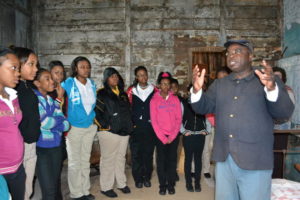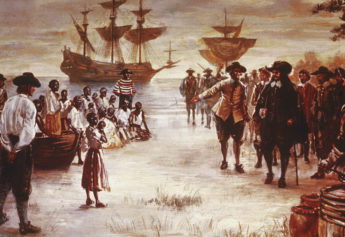
Joseph McGill (right) on a tour with a group of students. (The Slave Dwelling Project)
Joseph McGill is currently undergoing a project that might make many Black people uncomfortable. He is preserving slave quarters around the country — and also sleeping in them to understand what enslaved Africans might have felt.
McGill, founder of the Slave Dwelling Project, believes in making history a living, hands-on event. He also participates in Civil War reenactments as a founding member of the Company “I” 54th Massachusetts Reenactment Regiment in Charleston, S.C. This is the famed all-Black regiment depicted in the film Glory.
A former member of the National Trust for Historic Preservation, McGill feels it is important to save historical places such as slave quarters.
“Five years ago, my experience with being a preservationist and a Civil War reenactor morphed into the Slave Dwelling Project. The concept is simple: Find extant slave dwellings and ask the owners if I can spend a night in them in order to bring much-needed attention to these often neglected dwellings,” he said in an interview on Lee & Low Books’ website. Lee & Low Books is a publishing company that produces multicultural children’s books.
McGill also organizes tours of former slave quarters and says he has slept in more than 80 of them to date. This can be an unsettling experience.
“The experience that moved me the most was the opportunity to stand on an auction block at Seward Plantation in Brenham, Texas,” he said. “I thought about enslaved people standing on auction blocks having to expose their backs to show the potential buyers that there were no scars on their backs. Scars were indications that they were defiant and were beaten. No slave owner wanted to buy a defiant enslaved person to insert among his already docile and broken enslaved people.”
However, not everyone was enamored with McGill’s project. He initially ran into resistance from people who currently own the plantations.
“The reception of this project to plantations and property owners has been mixed,” McGill said. “As expected, five years ago trying to convince those property owners of my intent was a challenge. Despite that, far more stewards said yes than no, which gave me that confidence to step out on faith to embark on this journey. Five years later, the project is still going strong and has become the clearinghouse for all matters pertaining to extant slave dwellings. More site stewards now reach out to me than I reach out to them.”
According to McGill, the Slave Dwelling Project plays an important role in not only preserving an important part of American history, but also clearing up misconceptions. Today, some white people tend to look at the pre-Civil War period through rose-colored glasses and downplay how horrific it was. For example, a recent book on George Washington depicted smiling slaves.
In January, Margaret Biser, a former tour guide at a plantation in the South, published a revealing article on Vox detailing some of the ridiculous questions white Americans asked her about slavery. Those included questions like, “How much did the slaves get paid?” and “Did the slaves appreciate the care they got from the mistress?”
McGill says his project clears up those misconceptions.
“No one should portray slavery as being good for this nation. No one should portray the enslaved as being satisfied with their lot in life because that is that false narrative that needs to be corrected,” he said.


